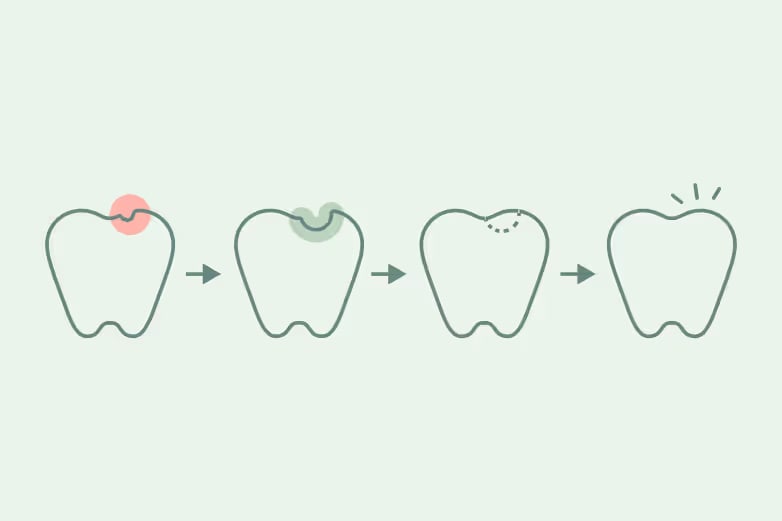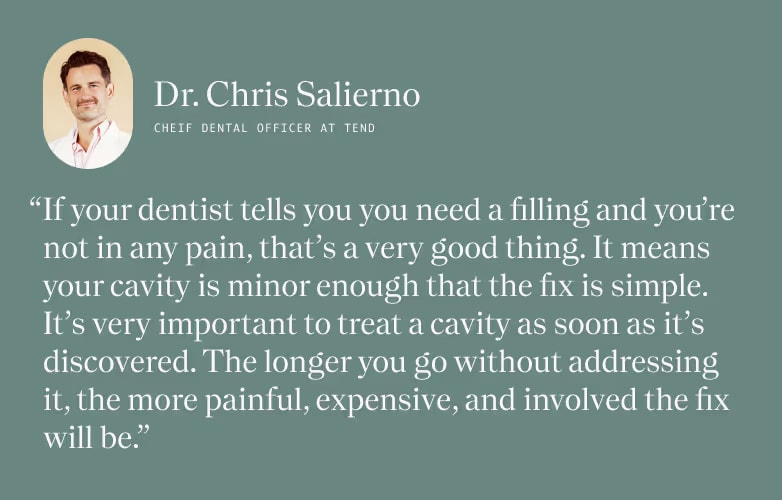You’ve just finished up your routine cleaning at the dentist, when you learn you have a cavity. Not exactly the news you wanted to hear, we know. The dentist says you need a filling—but is that really necessary?
Absolutely. Just because tooth cavities, or dental caries, are an incredibly common dental issue (over 90% of adults have one), doesn’t mean they aren’t a serious one. What exactly is a cavity? It’s an area where a tooth has started to decay.
The problem—teeth can’t heal themselves. If you have a cavity, it won’t get better. In fact, it will only get worse, more painful, more expensive, and more complicated to fix. So even if it’s not painful, a cavity is always serious.
Fortunately, the solution is simple and usually covered by insurance. A filling is a small (and nowadays painless) treatment that will keep you smiling and your mouth healthy.
Tooth Fillings: Everything You Need to Know
Want to know more about fillings? We can fill you in. Fillings are a treatment for cavities, so let’s start at the beginning.

What is a dental filling?
“A dental filling is a simple, safe treatment used to restore a tooth that has been damaged due to a cavity,” says Tend Chief Dental Officer Dr. Chris Salierno. “We use a special material to fill the hole left by a cavity and return your tooth to its original condition.”
Which type of filling your dentist uses will depend on several factors, like your own preference, insurance coverage, and where in the mouth the filling is being placed—molars may need a stronger filling material than other teeth, for example. Although amalgam fillings and gold fillings have been used for hundreds of years, modern dentistry has increasingly leaned towards composite fillings—often a combination of quartz or glass bonded to a resin base. It’s what we primarily use at Tend. These restorations are durable and tooth-colored for a natural look.
What is a cavity?
A cavity is an area on a tooth that has started to decay because of a buildup of plaque and bacteria. This decay causes a hole to form in the surface of the tooth. This damage is, unfortunately, permanent—even if the tooth doesn’t hurt yet. Sometimes you can spot cavities with the naked eye—you may even see visible holes—but the best way is to have a dental exam (which is included with every cleaning you get at Tend).
There’s a myth we’d like to bust about cavities. Just because you have one doesn’t mean you’re doing anything wrong. It’s a lot more complicated than simply avoiding sugary foods—some mouths are just more cavity prone than others and there are a lot of factors to consider. Brushing with a fluoride toothpaste and flossing regularly is the best way to prevent cavities, but good oral hygiene alone is not a guarantee against them. So if you have a cavity, don’t feel bad. (And we won’t try to make you.) Let’s fill it, and get you back to health.
“Unfortunately, cavities represent permanent damage,” explains Dr. Chris Salierno. “You can’t brush away cavities. The good news is, fillings and dental crowns are a simple and effective way to treat them.”
Is a dental filling always required to treat a cavity?
In a word: yes. Cavities won’t get better on their own; in fact, left untreated, they’ll get worse.
Eventually, the hole in your tooth will get bigger, growing past your tooth enamel (the hard, outer layer of your tooth), to the softer dentin underneath. From there, it can quickly reach the sensitive pulp and nerves at the root of your tooth, where it will form a painful abscess. By that point, a filling might not be enough treatment to save your tooth or prevent a serious infection. Instead, your dentist may need to try more invasive treatments like a root canal—or even a tooth extraction.

How long can you leave a cavity untreated?
“If your dentist tells you you need a filling and you’re not in any pain, that’s a very good thing,” says Dr. Chris Salierno “It means your cavity is minor enough that the fix is simple. It’s very important to treat a cavity as soon as it’s discovered. The longer you go without addressing it, the more painful, expensive, and involved the fix will be.”
In fact, one of the reasons Tend studios recommend twice yearly visits is so your dentist can make sure no cavities are left untreated for too long. The early stages, when you still have a small cavity, represent the best times to treat it. Typically, this is before you have much tooth sensitivity and before your dental health is severely affected.
How long do fillings last?
Most fillings are designed to last well over a decade, although it depends on the material used. Grinding or clenching your teeth can also shorten the lifespan of a filling. If you notice pain or sensitivity around your filling, contact your dentist to see if your filling needs to be replaced. They may do X-rays to check for any further decay under the filling.
Your dentist will also monitor your fillings at your regular dental check-ups.
Cavity Fillings: What to Expect
If your dentist tells you you need a filling, you may feel a little nervous or unsure: will it hurt? Is it expensive? How long will it take?
Top Reasons to Get a Filling
Fillings are a safe, effective way to treat cavities. Left untreated, cavities can cause severe pain and toothaches. They pose a real risk to your oral health and, ultimately, your overall health. Getting fillings promptly keeps your mouth in top shape.
Besides treating cavities, there may be other reasons to get a filling:
- To correct any non-cavity holes in your teeth—and keep bacteria from building up in those holes
- To repair a fractured tooth
- To repair a chipped tooth
- To correct discoloration on teeth
Is it painful getting a filling?
“Fillings don’t hurt at all,” explains Dr. Chris Salierno “We’ll apply a local anesthetic before beginning the treatment, so you won’t feel a thing. The pain of an untreated cavity is much, much more severe than anything you’ll feel getting a filling.”
After the anesthetic wears off, you may feel some minor soreness, but that should fade quickly.
What to Expect When You Get a Filling at Tend
“Getting fillings at Tend is a fast, easy process,” says Dr. Chris Salierno. “Most patients are surprised by how straightforward and painless their experience is. A minor filling only takes about 20 to 30 minutes to perform.” (If you have multiple fillings to do or deeper cavities, expect your appointment to take a bit longer.) Here’s how the process generally works.
First, your dentist will coat your mouth with a bit of numbing gel, then apply a local anesthetic. (You may feel a bit of a sting for that part, but that’s it!)
Once you’re totally numb (and zoning out to your favorite streaming show), your dentist will remove the decay. Then, your dentist will fill the hole with the filling material. They’ll use a special light to set or harden the filling as they go. Finally, your dentist will polish the tooth, leaving it good as new!
Does insurance cover the cost of fillings?
Yes, most in- and out-of-network insurances do cover the cost of fillings.
If you’re scheduling your filling at Tend, the studio team will let you know any cost you may be responsible for, as well as how much will be covered by insurance. (Pro tip: you can also check the cost of your treatment plan by using the Tend App!)
Cavities FAQ
-
Can you get a cavity filled while pregnant?
The American College of Obstetricians and Gynecologists and the American Dental Association agree that cavities can (and should!) be treated safely at any point during pregnancy.
-
How are cavities filled?
Filling cavities is a very common aspect of routine dental care. First, a dentist will dry the area of the mouth that needs the filling, then numb it.
A special drill is used to fully remove the tooth decay, then the hole in the damaged tooth is cleaned before being filled with the filling material. They’ll use a special light to set and harden the filling. Finally, the dentist checks that your bite is even and polishes the tooth. (And because all of this is done with a local anesthetic, it doesn’t hurt.)
-
How can I get rid of a cavity without a filling?
There is no way to get rid of a cavity without a filling.
In the case of more severe tooth decay, a dentist may use a dental crown, instead of a filling, in order to correct the damage.
-
Why is my tooth sensitive after getting a cavity filling?
It’s normal to experience some sensitivity after getting a filling as your mouth adjusts. Maintain good dental hygiene, regular brushing, flossing, and rinsing with fluoride mouthwash, and this should fade within a few days. If the tooth pain gets more severe or if you feel sharp pain, contact your dentist.
You may also notice pain with your bite after getting a filling. If it doesn’t subside, contact your dentist. They can smooth down the filling to line up better with your other healthy teeth, which should eliminate any discomfort.
Do you think you need a filling?
Speak with our expert team during your next Tend dental exam.